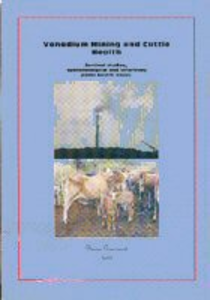Vanadium Mining and Cattle Health: sentinel studies, epidemiological and veterinary public health issues
Gummow, Bruce (2005) Vanadium Mining and Cattle Health: sentinel studies, epidemiological and veterinary public health issues. University of Utrecht, Utrecht, Netherlands.
![[img]](https://researchonline.jcu.edu.au/9409/1.hassmallThumbnailVersion/9409_Gummow_2005_cover.jpg)
|
Image (JPEG) (Front Cover)
- Cover Image
Download (61kB) |
|
|
PDF (Front Pages)
- Supplemental Material
Download (175kB) |
||
|
PDF (Back Pages)
- Supplemental Material
Download (474kB) |
Abstract
The thesis covers a field outbreak investigation into the cause and pathogenesis of "illthrift" on a dairy farm that was due to vanadium exposure, it examines methods of treating vanadium poisoning in cattle using an experimental study, looks at the use of cattle as sentinels for detecting and monitoring vanadium pollution, and examines the public health implications of cattle being farmed in areas of high background vanadium levels.
The outbreak investigation found that vanadium poisoning manifested in animals 4 to 18 months old, which showed emaciation, chronic diarrhoea, and in some cases, rhinitis, conjunctivitis and recumbency followed by death. Post-mortem and clinical pathology findings indicated that malabsorption and immunosuppression were the basis of the pathogenesis in affected animals.
In the experimental study, CaNa2EDTA appeared to enhance the excretion of vanadium in calves, but there was no proof that the treatment had a protective effect against vanadium exposure.
During the sentinel study a stochastic exposure model was developed. The exposure model differs from most other approaches in several ways: 1.It does not rely heavily on extrapolating information from the point source to the point of exposure. 2. It incorporates the physiological constraints of the species exposed. 3. It takes into account oral as well as inhalation exposure and thus can account for intake from contaminated grazing, vegetables and crops grown in the area of pollution. 4. It addresses the common weaknesses in many models of insensitivity to terrain, by using measurements at the point of exposure. 5. It accounts for existing background concentrations of pollutants and pollutants from multiple sources and 6. the stochastic process and use of distribution functions accounts for variability in the data over time, which is usually a problem with long term studies.
Having developed and validated the exposure model, an exposure dose was then modelled for different periods that animals were exposed for and this dose was then correlated to a wide range of biomarker responses that were monitored during the trial. In live animals, a difference in response was found between the high exposure group and low exposure group with respect to serum albumin, monocyte and thrombocyte counts, and hair and faeces vanadium concentrations. No difference in vanadium concentrations could be shown for urine, the traditional occupational health biomarker. None of the other potential biomarkers examined proved to be of much value in determining or predicting vanadium exposure in Bos indicus cattle. Regression models are described for serum albumin, monocyte counts, faeces and hair, which showed the most promise as biomarkers.
Average concentrations of vanadium in the tissues of slaughtered cattle ranged from 0.08 to 2.94 mg/kg. Significant correlations were found between the exposure dose just prior to slaughter and the concentrations of vanadium in the coccygeal vertebrae, liver, diaphragm and rib-bone in descending order of magnitude. Other tissues showed poor correlation to the end-dose. The study also evaluated the public health risks of consuming meat and milk from cattle originating from areas high in vanadium. Using a stochastic model and lognormal distribution function to look at possible extreme tissue residue values that are likely to occur, it was concluded from current knowledge of toxicity in humans that the tissue and milk residues of vanadium from cattle should pose no health risk to the consumer. The sentinel study proved that cattle could be used in a mining environment to monitor health risks to both cattle and humans, as a risk communication tool for interested parties and as a way of studying the chronic effects of pollutants.



